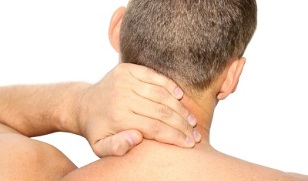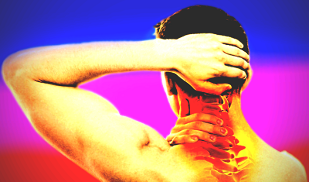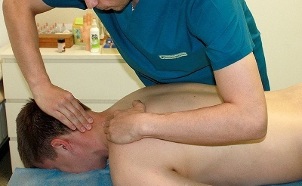Cervical osteochondrosis is a common disease accompanied by degenerative and dystrophic changes in the spine. The symptoms of the disease are the same in men and women. Treatment is prescribed by a physician depending on the severity of the lesions and the patient's condition.
Symptoms of osteochondrosis in men
The main symptom of cervical osteochondrosis is pain. There are a number of additional signs that can help determine the presence of degenerative lesions of the cervical spine.
Pain occurs against the background of disorders in the peripheral region, which is a result of its detrimental effect on the nerve roots and clutches that connect tissues, discs and muscles. Men with cervical osteochondrosis experience periodic or persistent pain. In the morning, the patient may feel dull pain in the depths of the neck.
Important!Unpleasant sensations occur with dizziness, coughing and sneezing.
Due to strong muscle tension, a man can not breathe deeply. The pain may spread to the occipital part of the head, indicating a damage to the occipital nerve.

When palpating the upper cervical vertebrae, a man may feel a painful lump. When nerve root compensation occurs, the discomfort can spread to the shoulder and arm area.
Cervical osteochondrosis is characterized by degenerative processes in the intervertebral discs.
Deterioration of blood circulation in the nerve nodes causes the following symptoms:
- burning pain in the back of the head;
- night numbness of hands;
- swelling of the hands;
- irregular heart rate;
- squeak and squeak when turning his head.
Vascular symptoms appear when the brainstem is affected. Cervical osteochondrosis disrupts normal blood flow in the vertebral vessels. Against the background of such pathological changes, neurotic failures occur:
- insomnia;
- unreasonable nervousness;
- vibrating gait;
- dizziness;
- fast heart rate;
- excessive sweating;
- memory impairment.
In some cases, the performance of the visual apparatus deteriorates. The danger of osteochondrosis is the development of the following syndromes:
- Stenosis. This is a narrowing of the spinal canal when the cerebral vessels are compressed by herniated intervertebral discs. The upper and lower extremities begin to converge.
- Reflex-irritant. This syndrome is accompanied by burning pain in the back of the head.
- Radical. With this pathology, the nerve roots are compressed by the intervertebral disc. The pains ache, burn, and throb.
In most cases, the symptoms of osteochondrosis in men are almost the same as in women. When the first attacks of pain occur, the patient does not always suspect cervical osteochondrosis. Timely diagnosis will help prevent complications.
Diagnosis of cervical osteochondrosis
X-rays are taken to diagnose the disease. It will help to make sure that there is no spinal cord injury. However, this research method does not provide an opportunity to see osteophytes. For this, more modern diagnostic methods are used.

Task execution:
- computed tomography;
- magnetic tomography;
- Ultrasound examination of cervical veins.
Computed tomography involves the creation of a series of X-rays that show the volume of the cervical vertebrae. Such details allow us to assess the nature of nerve compression, the height of the discs and the structure of osteophytes.
Magnetic resonance imaging is one of the most informative diagnostic methods. Allows you to assess the condition of bone structures. During the MRI, the doctor may detect a hernia.
If the doctor suspects bleeding disorders in the spinal arteries, duplex scanning is used.
Treatment of male osteochondrosis
Treatment is chosen depending on the degree of damage and the general well-being of the man. In most cases, medication and physical therapy are recommended.
HELP.Conservative therapy aims to reduce pain and relieve muscle spasms.
Physiotherapy activates regenerative processes in cartilage tissue. Such procedures can be part of a comprehensive treatment or an independent method.
The following procedures are defined:
- Electrotherapy.Affected areas of the spine are affected by electric current. This manipulation activates blood circulation. Contraindications include the presence of a pacemaker or metal parts in the patient's body.
- Magnetotherapy.This method involves exposure to a constant magnetic field. One procedure takes 20 minutes.
- Laser therapy.Helium-neon lasers are used. They increase bioelectrical processes in the tissues of the nervous system. Has anti-inflammatory, analgesic and wound healing effects. The duration of exposure to one area does not exceed 2 minutes, the whole procedure takes about 14 minutes.
- Shock wave therapy.This type of exposure is rarely used because of the controversy over its effectiveness. The effect is provided by acoustic waves. Helps boost metabolism & activate blood microcirculation
- Balneotherapy.Treatment is with mineral water and therapeutic mud. All nutrients penetrate the skin and affect the receptors and nerve endings.
Gymnastic exercises should be performed to restore mobility in the affected area. They will help strengthen the muscle corset and make the ligaments more elastic. The first exercises should take place under the supervision of a coach, because it is not the number of exercises performed, but their technique that is important.
Important!If medical treatment and physiotherapy do not give the desired result, surgery is indicated.

This is called a cervical discectomy. The doctor immobilizes the affected segment and removes the hernia, which puts pressure on the spinal nerve. Over time, the vertebrae grow together. 3-5 days after the operation, the patient is transferred to the clinic.
The rehabilitation period is about 3 months. The exact time of rehabilitation depends on the implant and the professional activity of the operated patient.
In any case, the treatment of cervical osteochondrosis is worth a visit to a doctor. Self-medication can aggravate the disease and lead to surgery.
Medications for treatment
Medications for osteochondrosis should only be taken with a doctor's prescription. Develops a therapeutic regimen and selects the optimal dose.
The following groups of drugs are prescribed:
- analgesics;
- antispasmodics;
- anti-inflammatory drugs;
- vasodilators;
- chondroprotectors.
HELP.The active ingredients not only relieve spasms, but also reduce the sensitivity of nerve endings.
Your doctor may prescribe non-steroidal anti-inflammatory drugs. These drugs reduce pain and reduce inflammation.
It is recommended to use drugs to reduce blood viscosity as a vasodilator. Improves blood microcirculation. Taking such drugs helps in rapid recovery after treatment of cervical osteochondrosis.
The action of chondroprotectors is aimed at activating the regeneration processes in damaged cartilage.

Improperly selected treatment can lead to the formation of a herniated disc. Hypertension with cervical osteochondrosis often occurs. If necessary, the doctor prescribes medication to relieve the symptoms of such a pathological condition.
Medication should be combined with medical gymnastics and physiotherapy procedures to be as effective as possible.
Try not to shave your neck after a chiropractic session. After the procedure, the muscles will relax to the maximum and you can reduce the positive effects of the session.
Nutrition for Osteochondrosis
Men with osteochondrosis should pay special attention to their diet. It must be balanced, because the body must receive enough vitamins and nutrients.
The following foods should be included in the diet:
- vegetables and herbs;
- berries and fruits;
- milk and fermented milk products;
- protein-rich foods;
- Foods containing gelatin and collagen.
Plant foods are high in vitamins and fiber. It has a low energy value that helps maintain a normal weight. Parsley, cauliflower, beets and broccoli are especially useful.
Patients with osteochondrosis are recommended to include sea oak in their diet. On the basis of fruits and berries, you can prepare jelly. Fermented dairy products are high in calcium, vitamin D and phosphorus. These vitamins and nutrients strengthen bones and cartilage tissue.
The daily menu should include the following products:
- fermented boiled milk;
- cheese without preservatives;
- yogurt;
- whipped milk.
It is important that milk and fermented milk products are natural, free of dyes and other harmful additives. Protein is essential for the formation of bone and cartilage tissue. Most are found in eggs, milk, whole grains and brewer's yeast.
Fish and seafood will benefit. Contains fatty & polyunsaturated acids needed for normal body recoveryCollagen is present in jelly, aspic fish and aspic. Promotes cartilage tissue synthesis
HELP.It is recommended to replace ordinary vegetable oil with extra virgin olive oil. It is important to maintain water balance.
Use only filtered or bottled water.
Most men see a doctor when they have osteochondrosis. There are a number of symptoms that indicate the development of a pathological condition. Timely diagnosis and treatment will help to avoid surgery and complications.



































